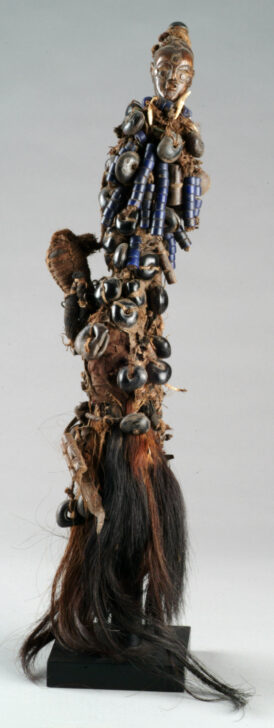Scepter
Songye

Description
Subject Matter:
According to art historian Niangi Batulukisi, this scepter is quite rare and is exclusively found in the northern Songye region within the Tetela territory in what is today the Democratic Republic of the Congo. The scepter which features a carved, wooden, anthropomorphic finial likely belonged to a Songye nganga, a diviner and healer, who serves as a clairvoyant spirit mediator capable of transversing the temporal and celestial realms. Able to detect and communicate with unseen forces, the nganga is seen to be gifted with secret insight into the invisible causes of human suffering. Consequently, he is charged with looking after community members by offering them diagnoses and treatments for both individual and societal crises and afflictions, such as infertility and plague. The anthropomorphic figure likely represents the spirit of a deceased diviner or an ancestor, whom the nganga appeals to for guidance. After the successful resolution of the client’s dilemma, a votive offering would be presented to the figure; here, for instance, a rich assortment of gifts adorn the body of the scepter including beads, pieces of metal, shells, teeth, and claws. Thus, the scepter functions as a type of portable altar, and its physical appearance would change over time through the offering of such accessories, reflecting the dynamic use and potent efficacy of the object.
Reference:
Maurer, Evan M. and Niangi Batulukisi. Spirits Embodied: Art of the Congo, Selections from the Helmut F. Stern Collection. Minneapolis: The Minneapolis Institute of Arts, 1999.
Physical Description:
At the top of this Songye scepter, is a finely carved, wooden finial that takes the form of an anthropomorphic figure which has a pear-shaped face, round eyebrows, large pupils, and an open mouth. Additionally, scarification patterns appear on the forehead and temples. The body of the scepter is laden with a rich array of man-made, plant, and animal materials that have been affixed to it, namely, multiple strands of blue beads and small pieces of metal, seeds, vegetable fiber, shells, teeth, claws, and animal skin whose long hair falls in a cascade.
Usage Rights:
If you are interested in using an image for a publication, please visit https://umma.umich.edu/request-image/ for more information and to fill out the online Image Rights and Reproductions Request Form.